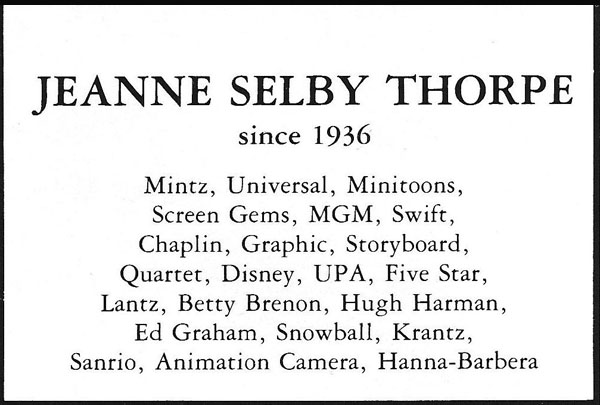Today’s set of video chats by Dan McLaughlin from The Animation Guild’s 1986 Golden Awards Banquet are with two ink and paint veterans: Betty Louise Smith and Jeanne Selby Thorpe. Unfortunately, little seems known about their careers aside from these interviews.

Smith started out at Disney’s in 1936 working on Snow White, “learning how to ink and paint.” Her career at the Mouse House seemed to end after she manned the picket line during the 1941 Disney strike, at which time she was making $22.50 a week. From there she went to Screen Gems before leaving the business for 8 years to raise a family. Then, she noted, “as some families go, [I] got a divorce, and had to go back to work.” She landed at MGM, working with Joe Barbera and Bill Hanna and followed them when they later set up their TV studio, recalling “I was with them for a long time.” Smith She retired early to go into the travel business, but “working in a business office was not my cup of tea. So, I went back into the cartoon business with Hanna-Barbera and then stayed there until ’81, when I moved to Ashland, Oregon.” The other companies she worked included Tempe Toons, DePatie-Freleng and Filmation. She passed away in 1998.

Thorpe started out as a painter at Mintz in 1936, later moving to Lantz and Screen Gems before joining the Navy in World War II. There she became head of the Ink and Paint Department of the Navy Photo Science Lab in Anacostia, in Washington, DC. After the war, she became “a supervisor of ink and paint and a supervisor of animation checking several times.” The studios she worked for included MGM, Graphic, Storyboard, Quartet, Disney, UPA, Betty Brenon, Hugh Harmon and Ed Graham. “The last time that I worked,” she recalled, “was at Hanna-Barbera for quite a few years as an animation checker and scene planner.” She retired in 1979, noting that while she missed the people and the humor, she didn’t miss the stress of the increasingly short working seasons that characterized TV production at the time.
Of particular interest were Thorpe’s frustration of being locked into a career in ink and paint, simply because she was a woman — sentiments undoubtedly shared by a more than a few of her sisters in arms. She pointed out that “sometime after I went in the business, women were allowed in other departments. We only had women in supervising jobs of ink and paint and ink check and paint check. The war changed that, because there were a lot of men that left to go into the services and women became inbetweeners and assistants and from there … [there were] women animators, women in background, women in editing, and so on. Had I had that opportunity, I’m sure I would’ve gone into something else, because I had gone to art school.”
Selby was married to former child star Gordon Thorpe for a short time. Their son, Anthony C. Thorpe, worked in film as a property master and even briefly headed Disney’s Property Department. She died in 2002.
Next week: Claude Coats.


 Harvey Deneroff is an independent film and animation historian based in Los Angeles specializing in labor history. The founder and past president of the Society for Animation Studies, he was also the first editor of Animation Magazine and AWN.com. Harvey also blogs at deneroff.com/blog.
Harvey Deneroff is an independent film and animation historian based in Los Angeles specializing in labor history. The founder and past president of the Society for Animation Studies, he was also the first editor of Animation Magazine and AWN.com. Harvey also blogs at deneroff.com/blog.




































































These Interviews are heavenly! Thank YOU!!!
I never did understand why women didn’t have a larger role in producing the animated cartoon. Surely, they could do their job well, and designing a character is also about the color scheme. Othere interviews with females here talk about how some women did work eventually as in-betweeners and such. Although I can also see, when reading in between the lines here, that the business of animation is stressful, with long hours and such. The only studio that I believe acknowledged the female inkers and painters by putting their images in a cartoon was Famous Studios in that one CASPER cartoon whose name escapes me now, and we see them leave screaming when they realize that the little transparent boy asking questions about the process of creating an animated cartoon was a ghost. But these interviews are amazing. There, again, should be a docu-movie about the history of the animation business from the stories of people’s lives, both the men and the women. Both women do say that animation has been “good to them”, so it is interesting that they always had that job to go to. Such a film would be another way of talking history through a different set of eyes, and animation has been there at some key moments in American history, documenting it or poking fun at it!
This may be a kind of awkward question, but we’ve seen specific animators posing for scenes to show the guys how a character should move. But, after mentioning that the inkers were caricatured in a Paramount/Famous cartoon, I wonder if the women were ever modeling or posing for certain character stunts of reactions. Of course, I know that there are always artist’s models; that’s a whole field in and of itself, but then, maybe all that was needed was to watch someone move a certain way and I wondered if, randomly, men and women about the studio would do that for the animators.